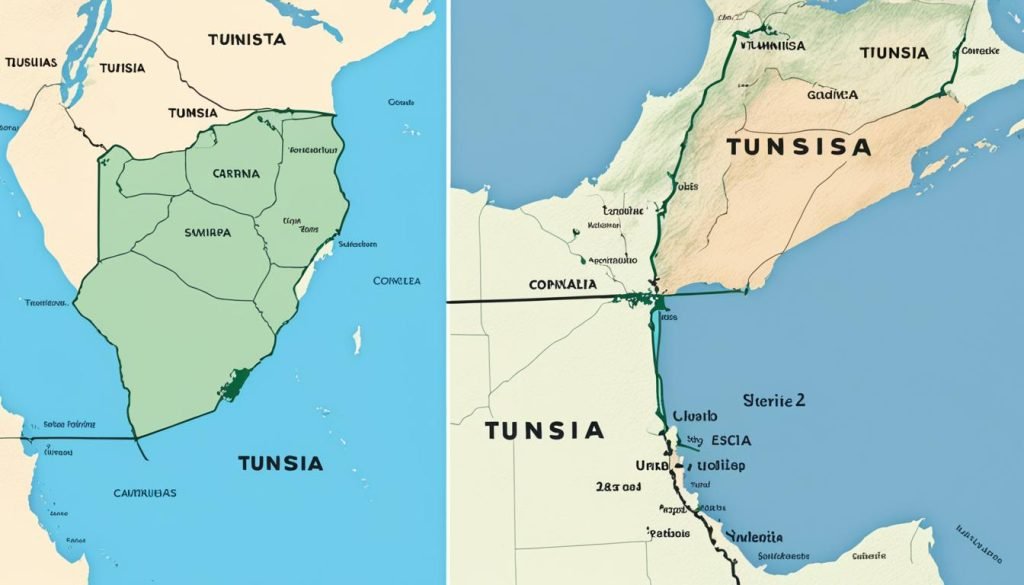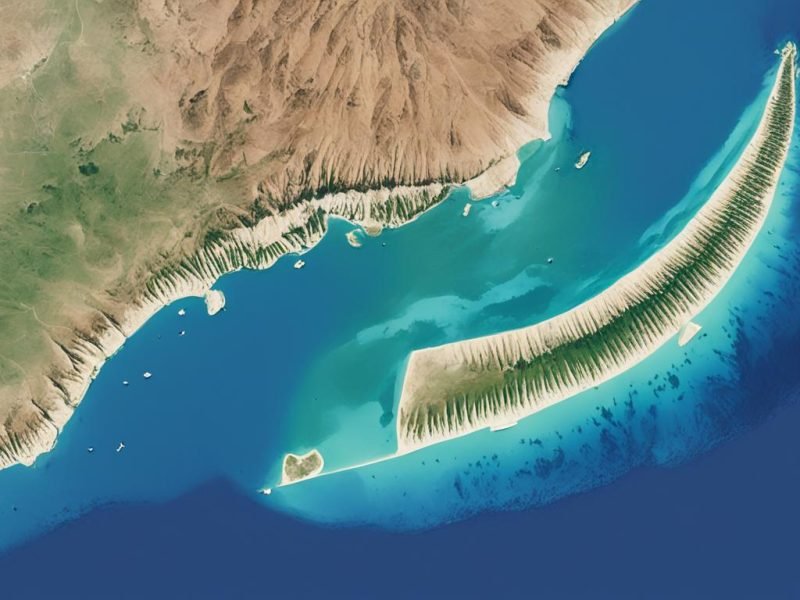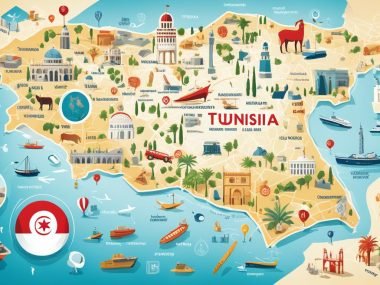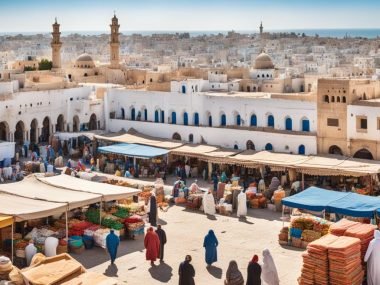The United States and Tunisia are very different in size. The US is huge, covering about 9,833,517 square kilometres. Tunisia, on the other hand, is much smaller. It has an area of just 163,610 square kilometres. This means Tunisia’s size is only 1.66% of the US’s total area.
When we look at the number of people living in each country, the difference is clear. About 337.3 million people live in the USA. Tunisia has a much smaller population, with only 11.9 million people. Maps that compare their sizes can be fascinating. But, it’s worth noting, the Mercator projection can make sizes look wrong, especially near the poles.
Key Takeaways
- The United States covers approximately 9,833,517 square kilometres.
- Tunisia’s land area is around 163,610 square kilometres.
- Tunisia’s land area accounts for about 1.66% of the United States’ total area.
- The population of the USA is roughly 337.3 million.
- Tunisia’s population is around 11.9 million.
- To-scale comparison maps enhance visual understanding of the size difference.
- The Mercator projection distorts sizes, affecting geographical comparisons.
Introduction to Tunisia and the United States’ Geographical Size
Tunisia is a North African country known for its beautiful Mediterranean coast and rich history. The comparison Tunisia and USA size shows a big difference in their sizes. These two countries are very different in their geographical sizes.
In North America, the United States has a wide variety of landscapes. From mountains and plains to coastlines and deserts, it’s got it all. Tunisia, however, is much smaller with an area of 163,610 square kilometres. It is much smaller compared to the USA.
Tunisia’s area is only about 1.66% of the vast 9,833,517 square kilometres of the United States. This big difference shows just how much larger the US is than Tunisia. Understanding these geographical sizes helps us see how diverse these two countries are.
Below, I have provided a table that shows the big difference in size:
| Country | Land Area (square kilometres) | Percentage of USA’s Land Area |
|---|---|---|
| Tunisia | 163,610 | 1.66% |
| United States | 9,833,517 | 100% |
Looking at these figures, the comparison Tunisia and USA size shows a stark difference. This basic knowledge about their sizes helps us understand more about these interesting countries.
How Big Is Tunisia Compared To The United States?
Looking at Tunisia versus the United States, we focus on size and people numbers. To get a clear picture, we use maps and the Mercator projection technique.

The Mercator Projection
The Mercator projection turns the round Earth into a flat map. It’s great for sailors but not perfect. Things get stretched out the further they are from the equator. So, places near the poles look way bigger than they really are. This matters when we compare the small, subtropical Tunisia to the much larger USA.
Population Comparison
Tunisia has about 11.9 million people, while the USA has 337.3 million. This huge difference shows us how varied the two countries are in life and culture. Tunisia’s cities are crowded, showing a different way people live there. In contrast, the USA’s huge area supports diverse ways of living and cultures.
Here’s a table showing how Tunisia and the USA differ in size and population:
| Country | Total Land Area (sq km) | Population |
|---|---|---|
| Tunisia | 163,610 | 11.9 million |
| United States | 9,833,517 | 337.3 million |
When we look at Tunisia next to the USA, the difference in size and how many people live there is striking.
The Size Ratio: Tunisia vs USA
The United States is much larger than Tunisia in terms of land. To put it into perspective, the USA’s land area is about 5,910% bigger than Tunisia’s. This shows a big difference in size between the two countries.
Land Area and Population Density
The United States has a vast land with areas that have few people. In contrast, Tunisia may be smaller, but it has packed cities like Tunis, Sfax, and Sousse. This creates a striking contrast between the two.
Let’s look closer at this contrast.
| Parameter | Tunisia | USA |
|---|---|---|
| Land Area (sq km) | 163,610 | 9,833,517 |
| Population | 11.9 million | 337.3 million |
| Population Density (people per sq km) | 72.7 | 34.3 |
Comparing the land and people, the size difference between Tunisia and the USA affects how people live. The USA has wide open spaces with few people. Meanwhile, Tunisia’s cities are bustling with life.
Tunisia vs United States Geographical Size
Comparing the geographical size of Tunisia and the United States shows big differences. Tunisia is in North Africa’s Maghreb region, known for its part of the Sahara Desert. This contrasts sharply with the United States’ wide range of landscapes.
The USA spans from the Atlantic to the Pacific coasts. It includes the Great Plains and Rocky Mountains. The country’s diverse landscapes mean a range of climates and time zones, unlike Tunisia’s smaller area.
The size difference between Tunisia and the USA is clear in their land. The USA has different ecosystems, like forests, deserts, and rivers like the Mississippi. Tunisia, however, is mostly its Mediterranean coast and desert areas.
To better understand these differences, here’s a table with key geographical facts:
| Country | Surface Area (sq km) | Major Geographical Features | Climatic Zones |
|---|---|---|---|
| Tunisia | 163,610 | Sahara Desert, Mediterranean coastline | Arid, Mediterranean |
| United States | 9,833,517 | Rocky Mountains, Great Plains, Coastal regions | Tropical, Arid, Continental, Polar |
This comparison highlights how different Tunisia and the USA are. Tunisia has specific landscapes, while the USA offers a wide variety. The size and variety differences between them are huge.
A Closer Look at Tunisia’s Dimensions
Tunisia might look small on a map, but its cities are full of life. They are important for both culture and the economy. Looking at how the country’s size divides among its cities shows us the urban scene clearly.
Major Cities in Tunisia
Talking about Tunisia, focusing on its major cities is key. Tunis is the bustling capital. It’s the heart of politics and culture. The old part of Tunis is a UNESCO site, showing the city’s rich history.
Next, there’s Sfax, known for its busy port and business scene. It mixes new with old, making it key to understanding Tunisia. Sousse is famous for lovely beaches and old forts. It draws tourists, helping the economy.
To sum up, Tunisia’s big cities are special in their own ways:
| City | Role | Key Features |
|---|---|---|
| Tunis | Capital | Political centre, historical sites |
| Sfax | Commercial Hub | Busy port, business activities |
| Sousse | Tourist Destination | Beaches, historical monuments |
Even though these cities are crucial to Tunisia, they might seem small compared to America’s urban giants. Still, they show how Tunisia’s layout creates its charm and economic strength.
Why Understanding Geographical Size Matters
Understanding the importance of geographical size is about more than just numbers on a map. It shapes a country’s economy, politics, and how it treats the environment. The size difference between Tunisia and the United States shows how land area can deeply affect a country.

When we talk about the importance of geographical size, economic effects stand out. The US, with its vast area, has lots of resources and space for farming and factories. Tunisia, however, has to make the most of what little land it has.
In political terms, the importance of geographical size is clear. Big countries often struggle to keep things running smoothly over large areas. Small countries, like Tunisia, may find it easier to manage their land but have less say on the world stage.
Environmentally, the importance of geographical size is also crucial. Big countries have to look after more land and different types of nature. Smaller nations feel more pressure on their natural resources because they have less room and possibly more people in that space.
- Economic Development: Bigger areas mean more chances to use resources and do different kinds of business.
- Political Infrastructure: A country’s size affects how it is run and how it interacts with other countries.
- Resource Management: The size of a place helps decide how to use resources wisely.
- International Relations: Big countries usually have more power and many friends. Smaller ones might focus on friendships nearby.
The difference in size between Tunisia and the US affects them at home and in the world. Understanding this helps us see the unique challenges and opportunities they face.
| Aspect | Tunisia | United States |
|---|---|---|
| Land Area | 163,610 km² | 9,833,517 km² |
| Population | 11.9 million | 337.3 million |
| Economic Opportunities | Limited by size | Extensive and diverse |
| Governance Challenges | More centralized | Managing vast distances |
| Environmental Management | Concentrated efforts needed | Diverse and widespread |
Conclusion
Comparing the size of Tunisia and the United States reveals so much about world diversity. We see how massive the U.S. is, with its various landscapes and time zones. In contrast, Tunisia’s smaller area shows us different cultural and economic stories. This size difference, with Tunisia being about 1.66% of the U.S., tells us a lot about each country.
This analysis shows how size affects a country’s growth and identity. Tunisia, with its 11.9 million people, is quite different from the U.S. with 337.3 million. Yet, both have their unique ways of life thanks to their sizes. This comparison makes us think about how land impacts resources, infrastructure, and global relationships. It helps us value each nation’s unique story and history.
Looking at Tunisia and the U.S. isn’t just academic. It helps us appreciate the beauty of our world’s variety. From Tunisia’s lively cities like Tunis to America’s vast landscapes, each detail matters. These comparisons deepen our knowledge and show how physical size influences a nation’s path. I hope this exploration between Tunisia and the USA opens our eyes to the rich diversity and identity shaped by size.







